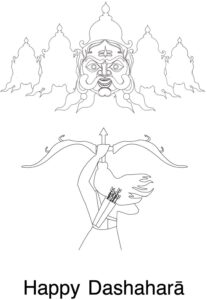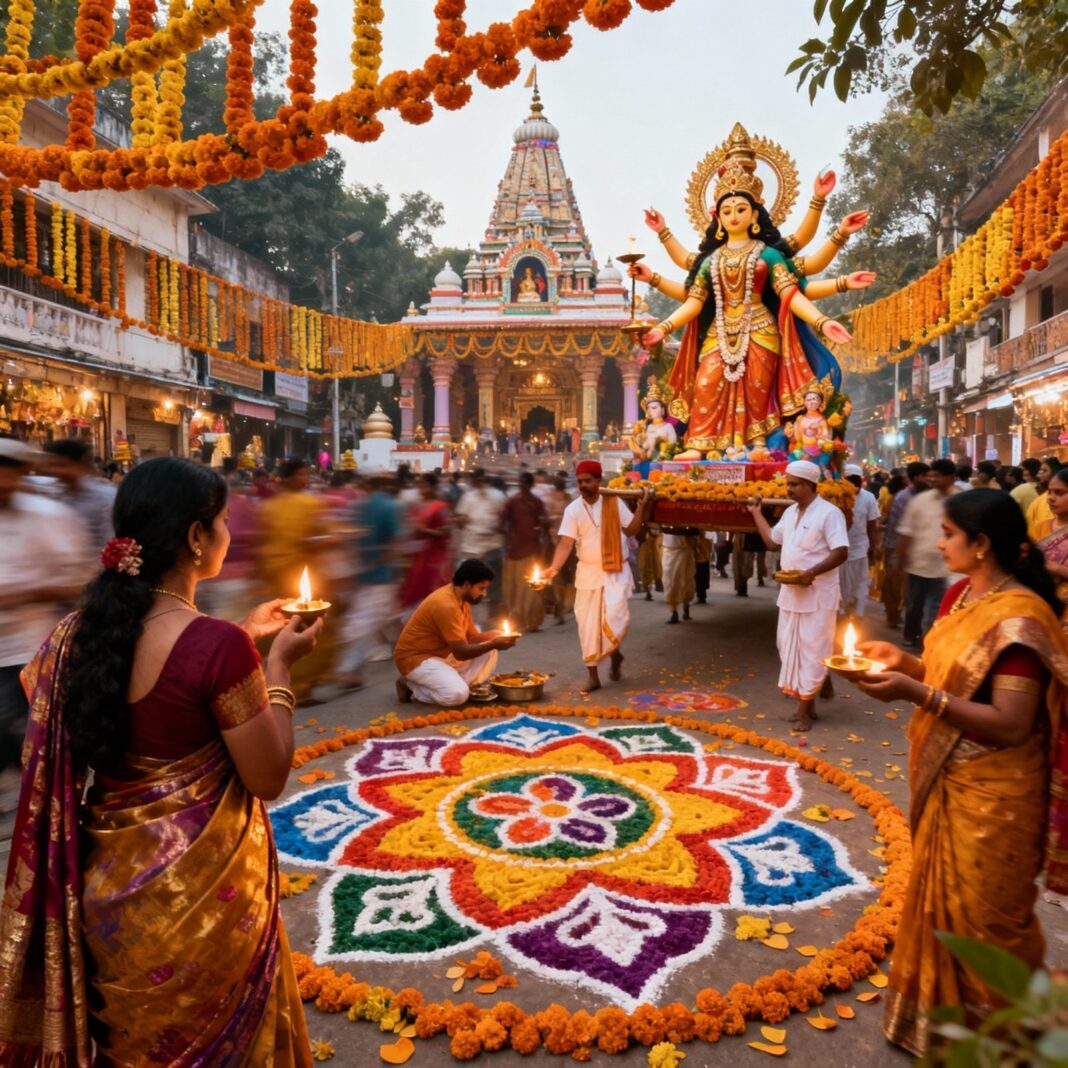Today, we celebrate Dashaharā (Vijayādashami), recognized as one of the three and a half most auspicious muhurtas – sacred periods – in Hindu traditions. Deeply rooted in cultural heritage, this festival transcends rituals and inspires action, courage, and renewal. It is observed by Hindus across the globe with great enthusiasm and vigour.
Spiritual Significance of Navarātri (nine nights preceding Daseharā)
Navarātri festival or Sharad Navarātri is one of the four Navarātris celebrated in a year, but it is by far the most significant and widely observed across India. In the Northern Hemisphere, Sharad Navarātri occurs during the Hindu calendar month of Ashwin (Gregorian calendar months of August-September) in the Sharad (autumn) season. “Navarātri” literally means nine nights, during which the devotee worships nine different forms of Goddess Durgā, also known as Navadurgā. During Navarātri, Hindus undertake a period of profound reflection, discipline, and spiritual rejuvenation. Over nine days, devotees strengthen their inner qualities through worship of Mā Durgā (Shakti—the embodiment of courage and strength), Mā Lakshmi (the goddess of prosperity and abundance), and Mā Saraswati (the goddess of learning, and wisdom). Each day offers opportunities to meditate, perform rituals, chant mantras, and engage in practices such as fasting or charity, all with the aim of purifying the mind, body, and soul. This nine-day journey symbolizes humanity’s struggle to overcome negativity, ignorance, and obstacles. Worshipping these goddesses and the powers behind them, guides us toward holistic growth, by combining strength, prosperity, and wisdom.
Dashaharā: The Triumph of Good Over Evil
Navaratri’s spiritual journey culminates in Dashaharā (Vijayadashami), a celebration of the victory of good over evil. The ten evils of Dashaharā are symbolically tied to the ten heads of RāvaNa in the RāmāyaNa, each representing a vice or negative quality that should be overcome to lead a righteous life. Many spiritual and cultural sources commonly list these ten inner vices as the evils to conquer: kāma (attachment), krodha (anger), lobha (greed), moha (delusion), mada (pride), mātsarya (jealousy), jaDatā (laziness), swārtha (selfishness), anyāya (injustice), and agyān (ignorance). These vices reflect the negative tendencies within each individual and the burning of the ten-headed effigy of RāvaNa on this occasion is a reminder to overcome these traits through self-discipline, compassion, and wisdom. Bhagawān Rāma overcame RāvaNa with his qualities of viveka (wisdom), vairāgya (detachment), āshā (hope), sheela (integrity), dheera (patience), kshamā (forgiveness), dhairya (courage), vinamratā (modesty), satyavākyah (truthful), and nigraha (self-regulation). Thus, Dashaharā marks a time when inner triumph is reflected outwardly, signifying the renewal of purpose and intent in personal and societal life [Kane, 1962].
Historical and Cultural Roots
In ancient India, Dashaharā signified the onset of Sharad Ṟtu—the post-monsoon season, characterized by clear skies and ripening crops. Considered an ideal time for new undertakings, this period was marked by rituals such as seemollanghan (“crossing the boundaries”). Communities would symbolically step beyond village limits and bring back Āptā leaves, which were exchanged as sona-patra (gold), celebrating expansion, prosperity, and courage [Thapar, 2002; Kulke & Rothermund, 2004].
Seemollanghan held special significance for royalty and symbolizing:
- Preparation for Expansion: Ceremonial initiation of campaigns for consolidating power or extending territories.
- Securing Dynastic Stability: Victories ensured the stability and prosperity of the ruler’s lineage.
- Prosperity: Collecting Āptā leaves signified blessings of wealth and success.
Strategic Relevance for Empires: The ritual reflected practical military strategy:
- Optimal Timing: Campaigns commenced post-monsoon when movement was unhindered.
- Psychological: demonstrate initiative and strength to both subjects and rivals.
- Empire Building: Strategic expansion led to enduring dynasties, exemplified by the Gupta, Pallava, and Vijayanagara empires.
Ultimately, seemollanghan combined ritual with strategic foresight and leadership.
Contemporary Relevance: Crossing New Boundaries
Today, while we may not march onto battlefields, Dashaharā invites us to cross personal, social, and cultural boundaries. The festival urges initiation of new ventures—whether in families, communities, or society at large—and to evaluate progress at each passing Dashaharā. For the Australian Hindu and Indian (AHI) community, Dashaharā symbolism resonates strongly. The AHI community is known for being:
- Highly educated and professional: Excelling in science, technology, medicine, and business [Australian Bureau of Statistics, 2021].
- Economically influential: Contributing through enterprise, trade, and innovation [ABS, 2022].
- Civic-minded: Upholding strong family values and low crime rates.
Despite these strengths, research shows our engagement often remains confined within cultural circles, resulting in limited awareness across broader Australian society [Australian Human Rights Commission, 2018; FECCA, 2021].
A Modern Seemollanghan: Building Bridges
Dushaharā inspires us to expand our horizons and forge stronger bonds with mainstream Australia, reinforcing the nation’s multicultural fabric. Suggested approaches include:
- Encourage Civic Participation
- Involvement in local councils, emergency services, and community boards.
- Launch mentorship programs supporting leadership among young AHIs.
- Social Outreach
- Partner with charities, hospitals, aged-care homes, and youth programs.
- Organize community-driven initiatives in collaboration with Australian NGOs.
- Sports and Cultural Integration
- Foster youth involvement in sports, arts, and cultural exchanges.
- Sponsor teams and festivals celebrating traditional Indian sports.
- Political Representation
- Advocate for greater representation in government, ensuring Indian-origin voices inform national policy.
- Conduct leadership awareness and training sessions.
- Narrative Building
- Share stories highlighting the contributions of AHIs.
- Partner with media and utilize digital platforms to amplify positive narratives.
Conclusion: Fetching Today’s Gold
The tradition of bringing home Aptā leaves as gold reminds us that prosperity comes from venturing beyond comfort zones. Seemollanghan’s core message remains timeless:
- Step beyond comfort zones and bring prosperity home: New initiatives generate not only material wealth but also social, cultural, and educational enrichment.
- Strategic planning: Prepare carefully for ventures just as historic rulers did.
- Sustainability: Forge long-lasting impact through foresight and planning.
For the AHI diaspora, this is an invitation to bridge the wisdom of ancient civilization with the dynamism of modern Australia. This Dashara, let us pledge to undertake our own seemollanghan—for social harmony, economic growth, and a stronger civic identity. Dashaharā is not just a festival of victory—it is also a festival of new beginnings.
On this Dashaharā, let us all start today, together.

References
- Kane, P.V. (1962). History of Dharmashastra (Vol. V). Bhandarkar Oriental Research Institute.
- Thapar, Romila (2002). Early India: From the Origins to AD 1300. University of California Press.
- Kulke, Hermann & Rothermund, Dietmar (2004). A History of India. Routledge.
- Australian Bureau of Statistics (2021, 2022). Census Data: Indian diaspora in Australia.
- Australian Human Rights Commission (2018). Leading for Change: Blueprint for Cultural Diversity and Inclusive Leadership.
- Federation of Ethnic Communities’ Councils of Australia (2021). Multiculturalism and Social Cohesion Report.




